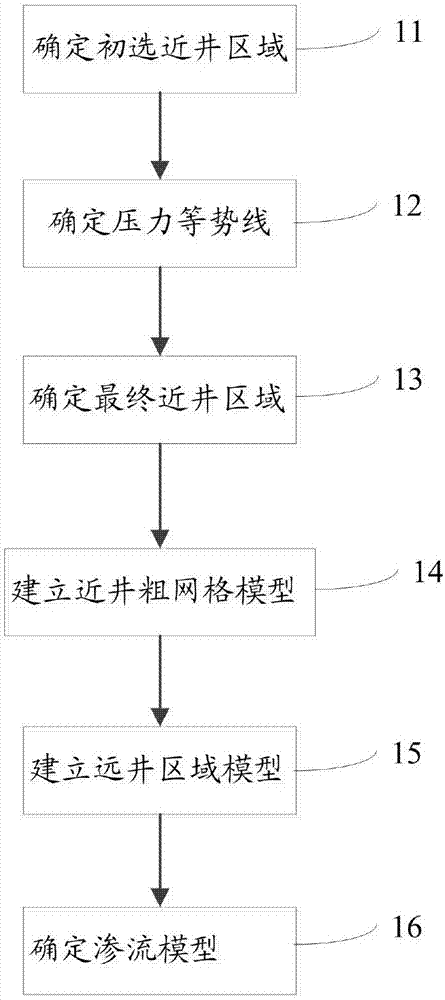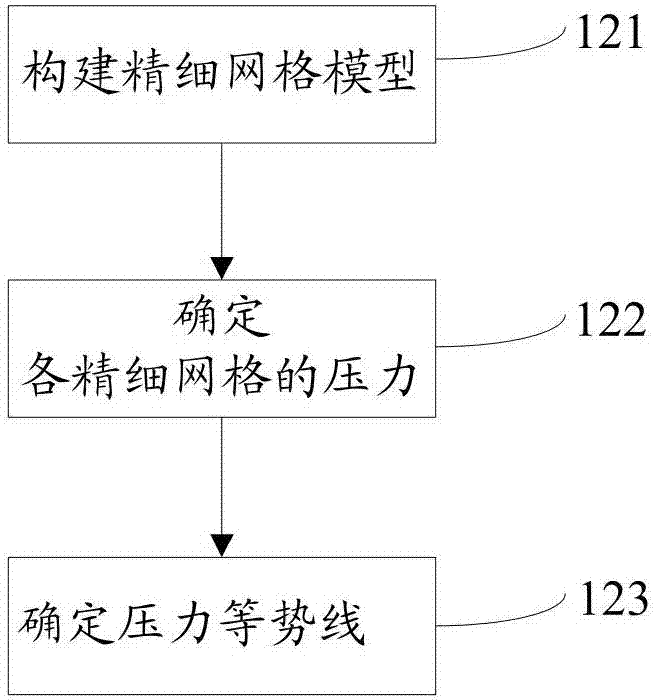Method and system for oil reservoir numerical simulation
A numerical simulation and oil reservoir technology, applied in the field of oil reservoirs, can solve problems such as inaccurate simulation results and inability to take into account near-well conditions, and achieve the effect of fewer grids and less computation.
- Summary
- Abstract
- Description
- Claims
- Application Information
AI Technical Summary
Problems solved by technology
Method used
Image
Examples
Embodiment 1
[0060] Such as figure 1 As shown, the reservoir numerical simulation methods include:
[0061] Step 11: Determine the primary near-well area based on the near-well effect occurrence area, where the near-well effect occurrence area includes at least one of the wellbore, fracturing fractures, and formation contamination zone. The formation contamination zone is due to completion methods or stimulation measures The pollution zone caused by the formation;
[0062] Step 12: According to the wellbore diameter and the seepage equation when the wellbore production reaches a steady state, determine the pressure equipotential line in the primary near-well area. In this embodiment, the seepage equation is a single-phase incompressible fluid equation;
[0063] Step 13: Determine the final near-well area according to the pressure equipotential lines;
[0064] Step 14: Establish a coarse mesh model of the final near-well area according to the pressure equipotential lines in the final near-well area...
Embodiment 2
[0076] Such as image 3 As shown, the reservoir numerical simulation system of the present invention includes:
[0077] The preliminary near-well area determination module 21 is used to determine the preliminary near-well area based on the near-well effect occurrence area, where the near-well effect occurrence area includes: at least one of the wellbore, fracturing fractures, and formation contamination zone, formation contamination zone It is a zone of formation contamination caused by well completion methods or stimulation measures;
[0078] The pressure equipotential line determination module 22 is used to determine the pressure equipotential line in the primary near-well area according to the diameter of the wellbore and the seepage equation when the wellbore production reaches a steady state;
[0079] The final near-well area determination module 23 is used to determine the final near-well area according to the pressure equipotential lines;
[0080] The near-well coarse grid mode...
Embodiment 3
[0091] Embodiment 3: The reservoir numerical simulation method includes:
[0092] (1) Determine the primary near-well area based on the near-well effect occurrence area:
[0093] Such as Figure 5 As shown, the research object of this embodiment is a vertical wellbore 51 with fracturing fractures 52 in the reservoir. The range of the primary near-well area 54 should be larger than the range of the near-well effect occurrence area 53, that is, the initial The selected near-well area 54 should surround the near-well effect occurrence area 53, so that the subsequent steps will not affect the flow in the near-well area in the calculation of the fine grid. The actual model is a three-dimensional model. To facilitate understanding, the schematic diagram is drawn as a simple two-dimensional conceptual model in this embodiment. Figure 5 Shown is a top view.
[0094] (2) According to the diameter of the wellbore, construct a fine mesh model of the primary near-well area:
[0095] The TetGen ...
PUM
 Login to View More
Login to View More Abstract
Description
Claims
Application Information
 Login to View More
Login to View More - R&D
- Intellectual Property
- Life Sciences
- Materials
- Tech Scout
- Unparalleled Data Quality
- Higher Quality Content
- 60% Fewer Hallucinations
Browse by: Latest US Patents, China's latest patents, Technical Efficacy Thesaurus, Application Domain, Technology Topic, Popular Technical Reports.
© 2025 PatSnap. All rights reserved.Legal|Privacy policy|Modern Slavery Act Transparency Statement|Sitemap|About US| Contact US: help@patsnap.com



